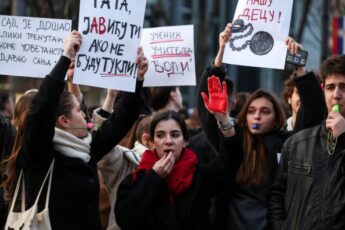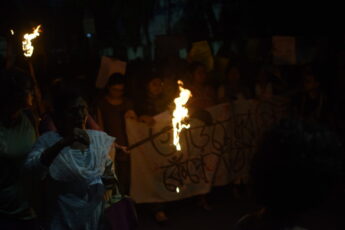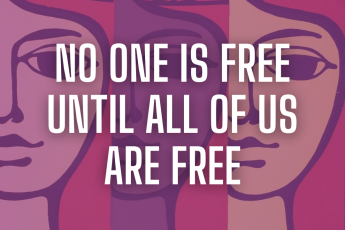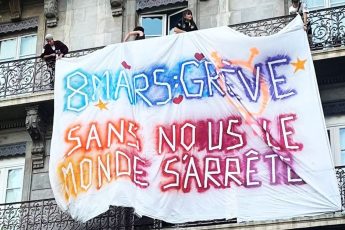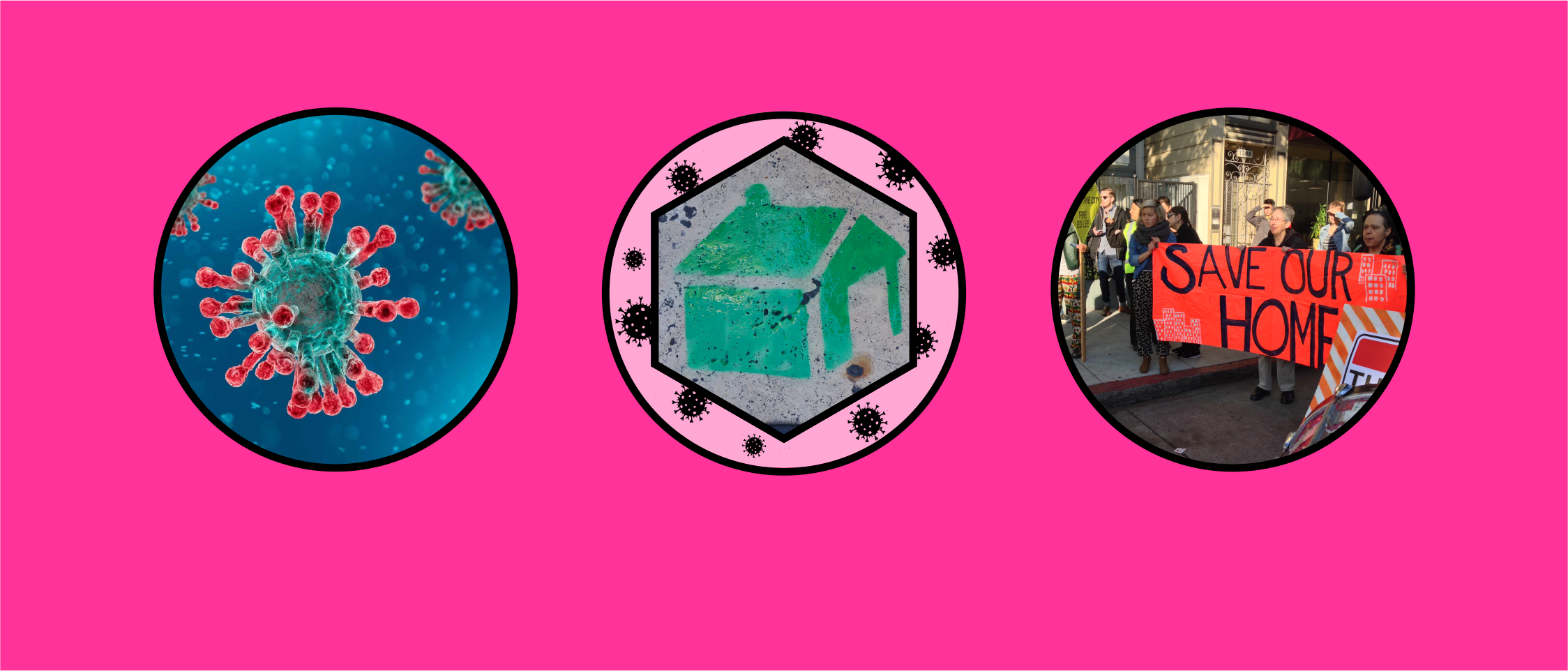
by VEDA POPOVICI
The present text, which we co-publish together with LevFem and Lefteast, is part of a series of publications on the topics of social reproduction, (women’s) labour and migration in East-Central Europe and beyond. Veda, an activist from Romania engaged in the struggles for housing justice and part of the E.A.S.T. network, talks about how during the pandemic problems of housing, exploitation of essential labor, patriarchal and racist violence intertwined. She also points out the need to organize transnationally in order to build a collective response, discusses what has been done so far and raises some crucial questions on what could be done in the future. For this reason she touches some crucial questions that will be discussed in the next E.A.S.T. public assembly, on 29th of November dedicated to “essential struggles against patriarchal violence”.
The social, health and economic crisis triggered by the COVID-19 pandemic has brought to the surface the underlying political problems in societies across the world while also forcing social movements to rearrange their visions, tactics and practices. In the last several months, new alliances have been emerging and efforts across borders are put into forming transnational networks. For movements fighting for housing justice 2020 has meant a growing momentum for their struggles. This piece looks at how housing injustice intersects with experiences of essential workers, effectively mapping out fields of overlap and intersectional acknowledgement and action. Supported by insights into practices of organizing by housing justice activists, such mapping offers new possibilities for transnational radical solidarity and action.
As history shows us, capitalism takes up any new crisis it faces with rapid rearrangements so as to ensure its survival. So, while capital reorganizes, the pandemic crisis intensifies, bringing more unbearable burdens for workers while authorities act unsurprisingly as an antechamber for corporations and private elites. For the months of March through June, governments and municipalities across the world have passed a variety of housing legislation that seemed to ease the burden of housing costs (EAC, 2020a). Although disproportionately benefiting companies, this legislation included social measures that were unthinkable just a month before. Now they were being passed without much fuss . Eviction moratoriums, rent freeze, rent decreases, mortgage postponement all were passed hastily, taking by surprise housing justice activists everywhere. By the time the UN called for moratoriums on evictions and foreclosures at the beginning of April, several countries were already implementing such measures. Housing came to occupy the center of the political conversation, with pro-capital economists launching new warnings of a possible housing crisis. Soon, it became clear that all of these measures form a grand deferral strategy, by no means actually alleviating the crisis but merely postponing it.
Organizing for housing justice in the midst of the COVID-19 pandemic
While activists were rapidly adjusting their demands and interventions to the new legislation, they were also facing an overnight deepened housing crisis. As it became clear that health and even survival depends on the capacity to stay at homes with as little physical interaction with others as possible, the already badly housed had been at high risk. These two conditions pushed housing movements around the world into a new stage of organizing effectively producing their radicalization and growth.
The European Action Coalition for the Right to Housing and to the City, a transnational network of grassroots housing justice organizations across Europe has published a report that looks at how the health, social and financial crises ignited by the COVID-19 pandemic have affected housing conditions and the organizing for housing rights in the period of March-June 2020 (EAC, 2020a). Based on my contribution to this research, it seems fair to conclude that just as the housing conditions worsened, our networks across the world grew stronger and have advanced more international solidarity and organizing.
In short, even though restrictions have greatly affected the capacity of organizers to continue their activities, groups across the continent adapted to the situation and responded swiftly and consistently. The main tactics used have been: a) mutual and direct aid; b) campaigning, advocacy, lists of demands; c) support, monitoring & consulting; d) rent strike or rent decrease; e) direct action; f) building alliances. Most organizations used at least two of these tactics in a cohesive strategy for a whole period of March-May 2020. While detailing how these tactics developed and overlapped, the EAC’s report shows that activists are expecting the crisis to deepen in the next year with housing issues and increased policing at its core.
The coordinated efforts of the EAC have proven to be a platform for many local groups and movements, most notably through publishing the 15 Demands in the Face of the COVID-19 Pandemic (EAC, 2020b) at the start of the pandemic (published March 28th). The demands, based on online campaigning, manifestos and demands written by various member groups of the EAC, featured some of the key issues that were to be developed in the months to come. Some of them are: “Moratorium on evictions in Europe!”, “No cuts on utilities, regardless of debts or formal status!” or “Suspension of all penalties for not paying rent or utilities!” as well as radical demands trying to anticipate new possibilities for the housing movements: “Immediate public requisition of hotels, tourist apartments, holiday houses and all empty buildings to re-house the homeless and the overcrowded!”, “Decriminalization of occupations of vacant buildings!” and “Decriminalization of all informal, alternative, ephemeral and mobile forms of housing!”.
Inspired by the demands of the EAC, the Block for Housing, a national alliance of housing justice organizations in Romania published the Manifesto for Housing Justice: Against the Pandemic of Capitalism and Racism (Block, 2020). The text serves as the axis of a wider campaign developed by the Block as a response to the pandemic crisis and includes tactics of online campaigning, pressure on authorities and support to its member groups for the continuity of their on ground organizing work. As many other movements around the world, the Block dedicated the month of May to labor rights. In the context of the pandemic, an intersectional vision that understands how labor and housing are linked became essential in the 2020 strategy of the alliances.
A local context with regional relevance
When trying to understand the nature of the housing crisis in the ECE space, we need to go beyond the myth of the “natural homeowners” (Florea and Vincze 2020), a political and discursive construct serving the legitimation of real estate capital. Big homeowner societies such as those in the post-socialist space are no substitute for secure or adequate housing. As Florea and Vincze show, homeownership does not guarantee increased quality of life but for the majority of the population in Romania “the only precarious resource in a deregulated market economy”.
While the great majority of households are mortgage-free, this does not mean they are debt-free. Access to public housing remains heavily restricted with the public housing stock dropping from 30% to less than 2% in 30 years. At the same time, the real-estate market in big cities has increased with an average of 43% only in the past 5 years. With the highest overcrowding rate (almost half of the total population), highest severe housing deprivation rate (37% of poor households and 16% out of all households) in Europe (Feantsa, 2020), Romania was already in a deep housing crisis by the time the effects of the pandemic installed.
With a percentage between 32 and 40% (depending on undeclared income) of all workers having minimum or below minimum wage (280 euros) and average keeping decent housing is a struggle even for home-owners. While almost 50% of all labor contracts are at minimum wage shows that a great percent of workers take several jobs to make ends meet while the private sector keeps the poor, poor with low wages.
While observing a trend of the steady increase of the gap between the rich and the poor for the past 10 years (Syndex 2019), this year’s crisis has triggered the termination of more than 400 000 employment contracts by the end of May. According to recent numbers, Romania may well have some 6 million people just above or under the poverty line, about half of the working population (Vincze, 2020). Outstanding in these statistics is the great increase of unemployment amongst women: with a staggering 48% (while unemployment amongst male identified workers has risen with 16%).
All of these processes are natural consequences of the violent neoliberal enclosure of non-private resources in the past 30 years. With private capital backed by transnational finance structures pushing for a precarization of the labor force so as to serve the unattractive labor in Western Europe. A supplier of cheap labor force, the global semiperiphery of ECE shares a recent history of neoliberal reforms that set the frame for the deepening of the current crisis. At the same time, the most affected – women, migrant and essential workers – have been at the forefront of protest and demand for rights (LevFem Collective and Transnational Social Strike Platform, 2020).
ECE workers – at the intersection of racism, gender violence and housing deprivation
Indeed, it is the same geopolitical structural inequality that disproportionately affected the lives of migrant workers from East and Central Europe. The infamous asparagus story amused and horrified the whole world. Presented as an anecdote, however it is actually representative for a key segment of seasonal migrant labor, ECE agricultural workers. In mid-April this year, a harvest worker from Romania died of the corona virus contracted on the asparagus farm he was working on in the South of Germany. About 20 more workers got infected owing to the lack of protection by the employer. The event sparked a greater debate about the protection and rights of Eastern European workers against the safe-guarding of the consumption habits of Western European populations (Boatcă, 2020). All in all, it was clear that the lifestyle of Western societies relied on Eastern Europe’s cheap and precarious labor force at the cost of the latters’ lives.
Migrant labor became increasingly risky, adding up to the burdens of housing, loss of employment, gender exploitation and gender violence. Key to organizing migrant care labor during the past six months has been the newly emerged DREPT pentru Îngrijire organization (RIGHTS for Carelabor with DREPT standing for justice, respect, equality, protection and transparency). Initiated as an online support group for care workers from Romania working in Austria, the group became a syndicated structure effectively organizing the members through mutual help and advocacy efforts. Through public events, it also brings awareness and raises solidarity for its community. Together with alliances with the Block for Housing and other social justice oriented groups, DREPT has successfully brought attention to the hardships of migrant care workers, predominantly women. Among others, they show that migrant care work – performed overwhelmingly by women – has been since March systematically devalued and underpaid. Illustrating the asymmetries between Western Europe and Eastern Europe, this type of work, although considered essential, has been excluded from governmental emergency subsidies.
These experiences are also linked with structural and social racism – of which the current crisis has also triggered an increase. Although of great variety across Europe , for the purpose of this short piece, I’ll focus on anti-Roma racism.
While anti-Roma racism remains at the heart of housing injustice in Romania, the new crisis has deepened dehumanizing and criminalizing narratives. As the state of emergency in Romania suspended several human rights, it is to be expected that the most vulnerable were affected, namely those whose rights were already volatile. Roma housing activist Maria Stoica reports that for poor Roma communities the emergency state measures didn’t mean much, as their rights have been continuously violated for many years (Stoica and Vincze, 2020). Stoica, a resident of the Cantonului community, near Cluj tells us about the perceived communication with authorities. When her community is told to “stay home”, they are in fact told to: “stay there in your poverty, we do not want to see you, we do not want to hear your complaints”. In April, a fire broke in one of the communities living next to the landfill in Cluj: one of the residents set his barrack on fire in protest against the lack of protection in face of the pandemic crisis. On another day, the police raided the community equipped in riot gear and throwing teargas so that the people sitting outside would go in their shelters.
Nicoleta Vișan, another colleague in the housing movement, also recounts numerous occasions of anti-Roma racist police violence reported in her online communities in and around Bucharest (Vișan and Popovici, 2020). Most notable in her account are stories of Roma homes being raided by police in what seem to be random acts of violence. Under the guise of discipling the unruly bodies disrespecting distancing measures, the state upped its anti-Roma position with a new level of direct physical violence. In addition to police brutality, overt anti-Roma racism consisted of restriction of access to utilities by local municipalities and an increase in stereotypical dehumanizing media representations (Costache, 2020). Housing activists across the region have expressed worries about an increase in surveillance and policing – an altogether reorganizing of violence (EAC, 2020a). The bodies at the forefront of such reorganizing are the ones already pushed at the intersection of various injustices.
Such are the residents of the Cantonului community, near the landfill of the city of Cluj. Notably, some of them, cleaning workers have been organizing towards syndication for a couple of years. During the emergency state, their situation has been increasingly tending towards precarity. Relying mostly on overtime paid labor, the new legislation cut down the limit for overtime while many were being sent home without knowing if they would be paid, put into technical unemployment or layed off. Efforts of these workers to unionize were rendered irrelevant with the new state of emergency legislation, suspending all rights to organize or strike.
For the ones already experiencing intersectional injustice, the crisis may feel like simply just another burden to carry as Nicoleta Vișan puts it (Vișan and Popovici, 2020). If we are to place the experiences and visions of such organizers and workers at the forefront of our struggles, we see a change in the narrative of crisis: as opposed to dominant narratives, we are not at all living extraordinary times, but just another stage in the true face of capitalism.
The gendered space of the home
The space of the home has long been identified as a battlefield in feminist literature and organizing. The current crisis has added a new layer of tension on the spatial politics of the home. As capitalism relies on unpaid domestic labor, so does now corona capitalism rely on the space of the home to compensate for the violence triggered by the pandemic. The already installed housing crisis only brought to the surface the severity of what it means to live in an overcrowded home or to lack access to basic utilities.
Enforced spatial constraint into one’s home has meant a day-to-day, for many a 24 hours forced facing of the acute overcrowding conditions they live in. Two important consequences have resulted from this: an increase in social reproductive labor and an increase in domestic violence. As schools and kindergartens as well as other social reproduction structures were closed, the needs of household members had to be catered differently. In the face of the incapacity of state and wider social structures to care for their members in a crisis, women are yet again the ones to provide domestic labor to compensate for this lack (Dattani 2020). To this we add the increase of domestic violence due to the stay-at-home restrictions. The home, thus, is not a given, nor is it safe when it is in fact accessible.
While the political dimension of the home has become more visible through the deepening housing crisis, women are also often at the forefront of housing organizing. These two conditions have overlapped during the past few months making the gendered dimension of housing injustice more visible through voices of women housing activists. Keeping in mind the high number of new unemployed amongst women, Vișan’s observation tha for women the current crisis has brought a four-fold more pressure sounds dauntly accurate.
The old or the new “normal”
For societies perpetually deemed in transition towards capitalist civilization, such as the post-socilaist societies of ECE, a crisis always feels like a painful and giant step back. However, this is simply another narrative serving the naturalized idea of the West being the ideal society to aspire towards . What analysis and organizing such as that of the local housing movement shows is that the current crisis is simply a new opportunity for capitalism’s reorganizing. The region, ruled by the hegemony of capitalist values, places private property at the heart of its moral compass (Popovici, 2020): you live in a decent home, you must be a good person/ you live in an overcrowded home or don’t have one, there must be something wrong and evil about you. In this climate, asking for public requisition of empty buildings and hotels, demanding public and social housing and the immediate housing of the overcrowded and homeless passes for communist propaganda. It seems to take back society to the forgotten era of actually existing socialism.
With an anticommunist regional consensus across the spectrum of the political parties in power, such demands are virtually ignored. In what feels like an uncanny déjà vu from 2008, the government is prioritizing keeping the real-estate market afloat, trying to prevent new dramatic drops of prices. Functioning as mere assistants to the circulation of capital for the corporate elite, governments throughout the world focused their interventions at maintaining the “normality” of the already existing housing crisis. In this context, analyzing the politics of housing proved to be essential to understand the trends in capitalism’s reorganizing (RHJ collective. 2020).
In Romania, talks of “economic recovery” serve as a code for increased militarization, policing and the support for the international capital’s continuous accumulation. Any hint of social protection, workers’ support or housing policies are deemed populist, ignorant or communist (Vincze, 2020). One important difference from the 2008 crisis is the increased state reliance on the military industry (Vincze, 2020). At its best, the return to “normal” announced by the government is a concentrated effort to go back to the business-as-usual conditions for exploitation, marginalization and violence.
Meanwhile, housing activists around the world are denouncing the new arrangement of real-estate capital and calling for a time when the rich pay for what they have stolen through labor exploitation, real estate speculation and the enclosure of public resources (Block 2020). Building transnational and cross-movement alliances seems as important as ever if we are to push back against 2020 going down as just another page in the disaster capitalism handbook.
Veda Popovici
References
Block for Housing. 2020. “Manifesto for Housing Justice: Against the Pandemic of Capitalism and Racism”, LeftEast. Article available here.
Boatcă, Manuela. 2020. “[Thou shalt] Honour the asparagus!: Romanian Agricultural Labour in Germany during the COVID-19 Season”, LeftEast. Article available here.
Costache, Ioanida. 2020. “Until we are able to gas them like the Nazis, the Roma will infect the nation:” Roma and the ethnicization of COVID-19 in Romania, DOR. Article available here.
Dattani, Kavita. 2020. “Rethinking Social Reproduction in the Time of Covid-19”, Antipode online. Article available here.
EAC. 2020a. Organizing for housing justice in times of the Covid-19 pandemic. March-July 2020. Available online: https://housingnotprofit.org/%ef%bb%bforganizing-for-housing-justice-in-times-of-the-covid-19-pandemic/#1
EAC. 2020b. 15 Demands in the Face of the COVID-19 Pandemic. Available online: https://housingnotprofit.org/15-demands-in-the-face-of-the-covid-19-pandemic/
Feantsa, 2020. Fifth Overview Of Housing Exclusion In Europe. Available online: https://www.feantsa.org/public/user/Resources/resources/Rapport_Europe_2020_GB.pdf
Florea Ioana and Enikő Vincze. 2020. “Homeownership, poverty, and legislative pitfalls in Romania”. Housing RIghts Watch. Published September 22, 2020. Available online: http://housingrightswatch.org/content/homeownership-poverty-and-legislative-pitfalls-romania?fbclid=IwAR0CRPoV_BO-5jjzx0GVciZ3jsS5eeZFbVCqhkKi0ksP0ubFsPPhCxtUZZE
LevFem Collective and Transnational Social Strike Platform. 2020. “Struggles in Social Reproduction during Covid19: from East to West and Beyond”, Transnational Social Strike. Article available here.
Popovici, Veda. 2020. “Residences, restitutions and resistance: A radical housing movement’s understanding of post-socialist property redistribution”. City Journal, March, 1-15.
Popovici, Veda and Nicoleta Vișan. 2020. “Tot împreună suntem mai puternice.Despre speranță, teamă și credința în lupta comună”. Cutra.
Radical Housing Journal Editorial Collective. 2020. “Covid-19 and housing struggles: The (re)makings of austerity, disaster capitalism, and the no return to normal”, Radical Housing Journal. Article available here.
Stoica, Maria and Vincze, Enikő. 2020. The suspension of Human rights during COVID-19: For Roma in Pata Rât they have been suspended for a very long time. April 27, 2020 Available online: http://www.criticatac.ro/lefteast/covid-19-roma-in-pata-rat/
Syndex, 2019. Situația salariaților din România, 2018-2019. Available online: https://www.syndex.ro/sites/default/files/files/pdf/2019-06/Situa%C8%9Bia%20salaria%C8%9Bilor%20din%20Rom%C3%A2nia%20%282019%29_0.pdf?fbclid=IwAR21kXOJdABiuLdg7Mu6gZbcTAJf4_3FPbAcFUP5Gi9QwOsa-kMismzZGWg
Vincze, Enikő. 2020. “Post-covid “Economic recovery” in Romania: forget labor, save capital, and support militarization?”, Focaal Blog. June 19, 2020. Available online: http://www.focaalblog.com/2020/06/19/eniko-vincze-post-covid-economic-recovery-in-romania-forget-labor-save-capital-and-support-militarization/


